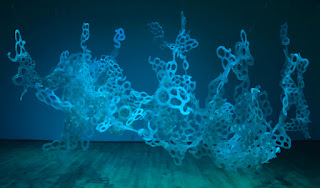Judy Byron & Art Matters
.jpg) Last Wednesday (November 28), Judy Byron organized and hosted a panel discussion called WHAT MATTERS: ART MATTERS -- An evening of conversation about making and presenting visual art in the District of Columbia. The panel was in connection with her current exhibition WHAT MATTERS, an ambitious installation of drawing, sculpture and sound recordings of women (who are also the models for the images in the show) conversing about life and priorities. You can participate by describing what matters to you. The exhibition is on view by appointment [judy@judybyron.com] until January 27; there are also more events coming up. (installation detail pictured; photo by Rick Rinehard)
Last Wednesday (November 28), Judy Byron organized and hosted a panel discussion called WHAT MATTERS: ART MATTERS -- An evening of conversation about making and presenting visual art in the District of Columbia. The panel was in connection with her current exhibition WHAT MATTERS, an ambitious installation of drawing, sculpture and sound recordings of women (who are also the models for the images in the show) conversing about life and priorities. You can participate by describing what matters to you. The exhibition is on view by appointment [judy@judybyron.com] until January 27; there are also more events coming up. (installation detail pictured; photo by Rick Rinehard)
At the panel, DCCAH Executive Director Tony Gittens described Commission programs and initiatives; Tim Davis, artist, teacher, and director of International Visions, Jayme McLellan, director Civilian Art Projects and I talked about our experiences in the world of Washington art. Mayor Fenty 
I first met Judy at a meeting she organized to establish a DC chapter of Artists Call Against Intervention in Central American, a group that sent art supplies to artists in El Salvador and Nicaragua and opposed illegal US support for death squads and the Contras during the Reagan years. The group was later memorialized by conservative critic Hilton Kramer in an overheated essay bemoaning the intervention of politics in art. He called it "an undisguised propaganda effort in support of the Marxist-Leninist revolutionary movement in Central America." Well, as John Berger [more calmly] once commented, artists do not necessarily welcome "the intrusion of politics into art." On the contrary, it is adverse political conditions that force artists to engage the issues.

 "We want to create a virtual women's network where we go to market selling young women and affluent women in a way that virtually no one else can," NBC Universal chief executive Jeff
"We want to create a virtual women's network where we go to market selling young women and affluent women in a way that virtually no one else can," NBC Universal chief executive Jeff 




 As it happens, I finished
As it happens, I finished 





 Not surprisingly, given the name Central Intelligence Art, we have apparently attracted the attention of whatever spy agency tracks art theory.
Not surprisingly, given the name Central Intelligence Art, we have apparently attracted the attention of whatever spy agency tracks art theory. 

















